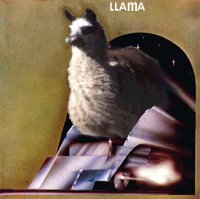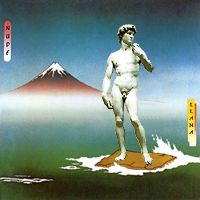The Llama Chronicles
Watch Out, They Spit! - The History of Llama
It was late winter of 1974 when four, unknown,
musicians stepped into the offices of Melbourne Records in Sidney -
Bruce (Guitar), Bruce (Drums, Percussions), Brucie (Keyboards) and Bruce
(Bass) were signed up to the label under the name Llama that very
same day and their first, eponymously-titled, vinyl beauty came out a
mere five months later.
 Although Llama's debut was certainly the
band's most accomplished musical feat to date, it was rather coolly
received. It sold fewer then 5 copies, two of them bought by Bruce's
(Drums, Percussions, Coconuts) parents.
Although Llama's debut was certainly the
band's most accomplished musical feat to date, it was rather coolly
received. It sold fewer then 5 copies, two of them bought by Bruce's
(Drums, Percussions, Coconuts) parents.
In 1974 noone foresaw that Llama would
change the world of music, advance Rock & Roll a few giant steps, be the
first band to play on Mars, nor even to claim the crown from King of
Tibet. And quite wisely so, as none of that ever happened.
 Fascinated by the possibility of success
as rock stars, Llama soon released another masterpiece. As sales were
going down, Llama decided to kiss up to their record company by
naming their new labour of love Melbourne.
Obviously, the sleeve designer was cross eyed, but the cover attracted a
brilliant tobacco manufacturer, who copied it to produce one of of
today's most fashionable cigarette brands. Fascinated by the possibility of success
as rock stars, Llama soon released another masterpiece. As sales were
going down, Llama decided to kiss up to their record company by
naming their new labour of love Melbourne.
Obviously, the sleeve designer was cross eyed, but the cover attracted a
brilliant tobacco manufacturer, who copied it to produce one of of
today's most fashionable cigarette brands.
1974 was Llama's last year with the original
line up. Bruce (bass) was to drop out to pursue a widely acclaimed
career as keeper of an Alpaca herd. Brucie (keyboards) refrained from
playing anything again, as, by the end of the recording of the first
masterpiece, he'd been found to be completely incompetent as a player at
all. Bruce (guitars) and Bruce (drums, percussions, rototom, tinkerbell)
were still in search of new musicians when the sessions for their 1975
extravaganza, Spitless began.
 Into the studio with Llama came George
(keys) and Bill (bass) in the summer of 1975. It was Bill who jotted
down Out on the Pram, a song notably different from
Llama's typical musical efforts, specifically because it featured
several DIFFERENT notes. Fortunately, though, this drastic change of
direction was disrupted as he left the band early on in the recording
sessions, to be replaced by Ewen (guitars) a few days later. And again,
a couple of days after that. Some weeks later, Bruce (guitars) noticed
the bass replacement was actually a guitarist, and that he was no longer
single-handedly in control of the string-driven-thing. So he sacked
Bruce (drums, percussions, whistles, mouth clicks) and went in search of
a new violin player instead.
Into the studio with Llama came George
(keys) and Bill (bass) in the summer of 1975. It was Bill who jotted
down Out on the Pram, a song notably different from
Llama's typical musical efforts, specifically because it featured
several DIFFERENT notes. Fortunately, though, this drastic change of
direction was disrupted as he left the band early on in the recording
sessions, to be replaced by Ewen (guitars) a few days later. And again,
a couple of days after that. Some weeks later, Bruce (guitars) noticed
the bass replacement was actually a guitarist, and that he was no longer
single-handedly in control of the string-driven-thing. So he sacked
Bruce (drums, percussions, whistles, mouth clicks) and went in search of
a new violin player instead.
After employing George Lennon (vocals,
tambourine - no relation!) and Jack McCartney (bass pedals - no
relation at all! ... honest!), Spitless finally saw the
light of day in December 1975... But for only a few moments, before the
hovercraft carrying the newly pressed albums sank on its way to the
continent. The album was received with mixed reactions. Some didn't like
it, some simply hated it, most couldn't care less, and apparently the
fish never knew what hit them.
 In 1976 it was clear that Llama had to find a new direction.
After giving it a few seconds of thought, Bruce (guitar, vocals, accordion,
silly arm-pit sounds, percussions) decided it was time to join the Metal Rock
trend. June 1976 saw the release of the heavily rocking I Can Lick Your Whip From Here. Originally
intended to match its name with an attractive S/M graphic sleeve, Llama decided instead to
annoy everybody with tasteless suggestions against farm animals. The new, fresh musical
approach gained Llama sales which barely succeeded those of their debut album, mostly
because Andy's (Drums, Coffee and Cigarettes) parent's were not interested at all.
The album, however, included the suggestive S/M track Your Love Is Stranger than Mine
and the Sharon Stone tribute track, Ice Pick, which featured a 20 minutes solo
of distorted, untuned violin. Listen to a sound sample here In 1976 it was clear that Llama had to find a new direction.
After giving it a few seconds of thought, Bruce (guitar, vocals, accordion,
silly arm-pit sounds, percussions) decided it was time to join the Metal Rock
trend. June 1976 saw the release of the heavily rocking I Can Lick Your Whip From Here. Originally
intended to match its name with an attractive S/M graphic sleeve, Llama decided instead to
annoy everybody with tasteless suggestions against farm animals. The new, fresh musical
approach gained Llama sales which barely succeeded those of their debut album, mostly
because Andy's (Drums, Coffee and Cigarettes) parent's were not interested at all.
The album, however, included the suggestive S/M track Your Love Is Stranger than Mine
and the Sharon Stone tribute track, Ice Pick, which featured a 20 minutes solo
of distorted, untuned violin. Listen to a sound sample here
 While I Can Lick was just a showcase of bad taste,
its runner up, Nude, set new standards for futile attempts at art.
Llama's new misfit sold so poorly, the record company
decided to pay them money for NOT recording anymore.
While I Can Lick was just a showcase of bad taste,
its runner up, Nude, set new standards for futile attempts at art.
Llama's new misfit sold so poorly, the record company
decided to pay them money for NOT recording anymore.
But, this is not the end of our story. Between 1979
and 1989 there were three hundred and twenty two releases of
compilations and collections of Llama's early efforts, some of
them double or triple boxed sets. Observing this, Bruce (guitar,
keyboards, drums, percussion, bass, flute, mandolin, ukelele,
didjeridoo, vocals) decided it was about time to reunite the old band.
This came about in early 1990, and has been a tremendous success ever
since.  Llama Hairdressing, the band's publishing company, has
since produced 21 live double CD releases, all recorded during the
band's two-nights-only tour of Antarctica (the first gig took place at
the south pole, the second in a Polar Bear community, which turned out
to be the band's final performance.) Llama Hairdressing, the band's publishing company, has
since produced 21 live double CD releases, all recorded during the
band's two-nights-only tour of Antarctica (the first gig took place at
the south pole, the second in a Polar Bear community, which turned out
to be the band's final performance.)
Llama's story was almost over, but... In 1995 it was dug out of its grave
by the Bag-O-Rats Record Company who released a 5 CD set entitled
Harbour Those Tears as a tribute to Llama. The songs were mostly
MIDI sequences downloaded from the Internet and then recorded while
being played live through a PC speaker. Apparently the 3rd and
the 4th CDs were repeated recordings of the first two ones, and
the 5th CD (sub-titled 'Rare Tracks') featured other bands' music.
Bag-O-Rats were indeed clever in estimating no one will notice the fraud,
as one couldn't remain listening after 5 minutes of this. The CD set includes a rare
unreleased track, salvaged from the tapes of the metallic I Can Lick... period:
a one-note-song called Watching the Bondage.
Ofir Z. Tracy 1997
|